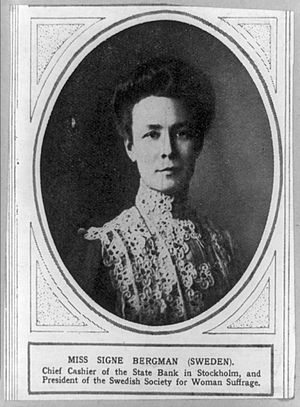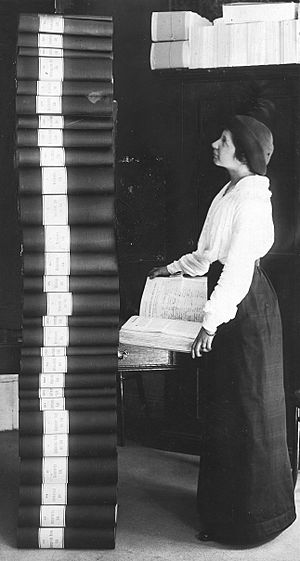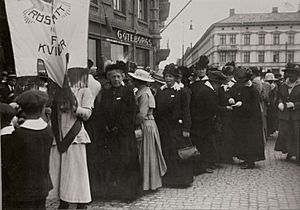National Association for Women's Suffrage (Sweden) facts for kids
|
Landsföreningen för kvinnans politiska rösträtt
|
|
| Formation | 1903 |
|---|---|
| Dissolved | 1921 |
| Type | Association |
| Legal status | Defunct |
| Purpose | Women Suffrage |
| Headquarters | Stockholm |
| Location |
|
| Methods | Agitation, campaigning |
The National Association for Women's Suffrage (known in Swedish as Swedish: Landsföreningen för kvinnans politiska rösträtt, or LKPR) was a very important group in Sweden. It worked to get women the right to vote, which is called suffrage. The LKPR was active from 1903 until 1921. It was part of a bigger movement around the world that wanted women to have equal voting rights.
The LKPR was similar to another group, the Swedish League for Universal Suffrage (SARF). But SARF mainly worked to get all men the right to vote. The LKPR was also connected to the International Alliance of Women, a global organization for women's voting rights.
Contents
History of Women's Suffrage in Sweden
Early Efforts for Women's Vote
The idea of women voting in Sweden first came up in 1884. A politician named Fredrik Borg suggested it to the Swedish Parliament. He believed it was fair for women to vote just like men. At that time, women who paid taxes and earned a certain income could already vote in local elections since 1862. Borg wanted them to vote in national elections too.
However, Parliament voted against his idea. One main reason given was that women themselves had not asked for this right.
Women Demand the Right to Vote
To show that women did want to vote, Agda Montelius and Gertrud Adelborg took action in 1899. They represented the Fredrika Bremer Association and presented a formal request for women's suffrage to the Prime Minister. They did not get a reply.
In 1902, two new ideas about voting rights came to Parliament. One was from the Minister for Justice, who thought married men should get two votes. He believed they voted for their wives too. This idea made many women's rights activists angry.
The other idea was from Carl Lindhagen, who suggested women should vote. Women's rights groups quickly formed to support Lindhagen's idea. Before his suggestion was voted down, they gathered many names. Over 4,000 women from Stockholm and nearly 1,500 from Gothenburg signed lists, showing they wanted to vote.
Founding the LKPR
Because of these efforts, the Föreningen för Kvinnans Politiska Rösträtt (FKPR) was started on June 4, 1902. Important founders included Anna Whitlock, Lydia Wahlström, and Signe Bergman. At first, it was just a local group in Stockholm.
The FKPR sent speakers to different towns to help start local chapters. By the end of 1903, so many local groups had formed that the organization changed its name. It became the Landsföreningen för kvinnans politiska rösträtt, or LKPR, meaning it was now a nationwide group.

How the LKPR Worked
The LKPR's main goal was for women to vote on the same terms as men. Before 1909, this meant they wanted tax-paying women with income to vote in national elections, just as they did in local ones. After 1909, when all men got the right to vote, the LKPR demanded that all women should also have that right.
The LKPR was the main group focused on women's suffrage. Other women's groups also wanted women to vote, but it was the LKPR's main mission. The LKPR also worked on other issues. For example, they wanted to end the law that said a husband was the legal guardian of his married wife. They believed that if women could vote, they should also be fully independent adults.
Funding and Members
The LKPR held yearly meetings with leaders from its local groups in Stockholm. The group raised money by selling postcards, holding Flea markets, and getting donations. Two very important supporters were Lotten von Kræmer and Martina Bergman-Österberg, who gave a lot of money to the movement.
Only women could be members of the LKPR. This was important because opponents of women's suffrage often said women didn't want to vote. By organizing themselves, women showed they were capable of political action. There was also a male support group, the Male Society for Women's Suffrage (MFKPR), which started in 1911.
Peaceful Protests and Public Image
The LKPR did not agree with the more aggressive methods used by some British Suffragettes. They worried that such actions would make people less supportive of their cause. The LKPR organized only one street demonstration. This happened in June 1918 after a women's suffrage bill was voted down.
In this protest, marchers carried three banners. One showed a male criminal, another a male patient in a mental hospital, and the third showed the respected author Selma Lagerlöf. The banners highlighted that these men could not vote, but neither could a highly respected woman like Lagerlöf. This demonstration was organized by Frigga Carlberg from the Gothenburg section, which was known for being more radical.
People sometimes unfairly described women who wanted to vote as not being feminine. Because of this, the LKPR suggested its members try to dress in a feminine way during their activities. They wanted to show that women could be both politically active and feminine.
Spreading the Message
The LKPR mainly built support by using newspapers, giving public speeches, handing out flyers, and talking to politicians. They also offered "Bergman-Österberg Citizen Courses," which taught women about their rights and prepared them to be voters. The LKPR also published its own newspaper, Rösträtt för kvinnor (Women's Suffrage), from 1912 to 1919.
The LKPR was officially a politically neutral group. Its leaders came from different political backgrounds, including Lydia Wahlström (conservative), Signe Bergman (social democrat), Anna Whitlock (teacher), and Ann-Margret Holmgren (liberal). Women from both left-wing and right-wing political views supported the group.
However, in 1911, the LKPR decided to stop supporting politicians who were against women's suffrage. This meant they mostly supported Liberals and Social Democrats, who were in favor of women voting.
Many famous women supported the LKPR. Selma Lagerlöf, a respected author, often gave speeches. Elin Wägner was also a very active supporter from 1909. Her novel Pennskaftet (novel) (1910) was very popular and was even called the "bible of the Swedish suffrage movement."
Key Actions of the LKPR
Petitions and International Meetings
In 1905, the LKPR asked the government to introduce women's suffrage. The government said it would happen after all men got the right to vote. In 1907, the next government refused to discuss it, saying an investigation was still ongoing. The LKPR sent a group led by Gertrud Adelborg to meet King Oscar II of Sweden, who promised his support.
A big event for the LKPR was the Sixth Conference of the International Woman Suffrage Alliance in Stockholm in June 1911. Many international speakers attended, including Carrie Chapman Catt. Selma Lagerlöf spoke at the Royal Swedish Opera, and Ellen Key spoke at Skansen. There was a large parade through Stockholm, which stopped to honor Lotten von Kræmer. The event received a lot of media attention.
In 1912, a bill for women's suffrage was proposed but voted down by conservative politicians. The LKPR was encouraged to collect more names to show public support. In 1913, the LKPR presented a list of 360,000 women who supported women's suffrage.

Peace Efforts During World War I
During World War I, the LKPR started a peace group with women from neutral countries. Their goal was to pressure neutral governments to help end the war. This peace movement included women from other groups like the Fredrika Bremer Association.
A large peace event was planned for February 1915, with support from women in Denmark and Norway. However, the Queen of Sweden, Victoria of Baden, and King Gustaf V of Sweden intervened. They warned that such an action could harm Sweden's neutrality. So, the event was stopped in Sweden, Denmark, and Norway. Despite this, the Swedish Peace Movement sent 16 delegates to an international women's peace conference in The Hague in April 1915.
Final Push for Suffrage
In 1917, the LKPR pushed for women's suffrage again. Several proposals were made in Parliament, but they were all voted down.
After the 1917 elections, the Liberal and Social Democratic parties won more seats. This meant there was now a majority in Parliament that supported women's suffrage. The LKPR reminded these parties of their promise to grant women the vote.
In February 1918, the government proposed a bill for women's suffrage. It passed in one part of Parliament but was voted down in the other. The LKPR organized a public protest meeting in Stockholm. Frigga Carlberg also organized the only street demonstration by the LKPR in Gothenburg.
Victory and Dissolution
After World War I ended, the government introduced a major plan for democratic reforms, which included women's suffrage. Because this required changing the country's constitution, two votes were needed in Parliament.
Women's suffrage was approved by Parliament on May 24, 1919. It was officially confirmed in January 1921.
Between 1919 and the 1921 election, a government committee was formed to update women's legal status. This included new marriage laws and giving married women full legal independence. Before this, married women were considered minors under their husbands' guardianship. The committee also worked on a law to give women equal access to all state jobs, which passed in 1923. This committee was led by Emilia Broomé, making it the first time a woman chaired a state committee in Sweden.
The LKPR celebrated its victory on May 29, 1919, with a party. There was music by Elfrida Andrée and a speech by Selma Lagerlöf. Groups from Denmark and Norway came to celebrate, and the LKPR also honored the Social Democratic Women, who had also worked for women's suffrage.
Once its main goal was achieved, the LKPR was dissolved. Many members joined the Fredrika Bremer Association. The central committee of the LKPR formed a new group called the Svenska Kvinnors Medborgarförbund (Citizen Society of Swedish Women), which continued to work on women's rights.
Chairpersons of the LKPR
- 1903–1907 – Anna Whitlock (first term)
- 1907–1911 – Lydia Wahlström
- 1911–1914 – Anna Whitlock (second term)
- 1914–1917 – Signe Bergman
- 1918–1921 – Karolina Widerström


